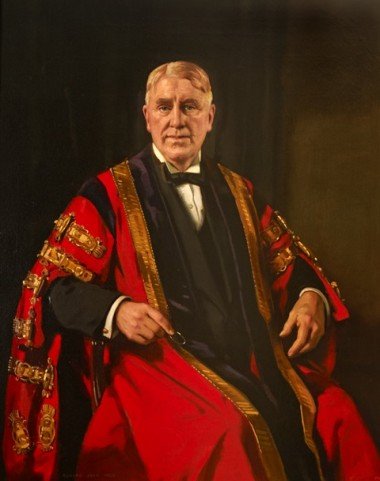
Portrait of Lord Moynihan
with permission form the Royal College of Surgeons of England
Positions held:
- President of the Royal College of Surgeons of England
- Hunterian Professor 1919-1920
- Bradshaw Lecturer 1920
- Professor of Surgery, University of Leeds 1925
- Huntarian Orator 1927
- Romanes Lecturer, Oxford 1932
- Walker Lecturer, St Andrews 1933
- Linacre Lecturer, Cambridge 1936
Berkeley George Andrew Moynihan was born in Malta in 1865 and died in 1936. He trained at the Royal Naval College and originally intended to follow his father into the army but decided that the Moynihans “had done enough killing. It’s time they mended their ways” (1).
He did his medical training at Leeds Medical School and the University of London achieving his M.B., M.S., in 1887. He subsequently became a Fellow of the Royal College of Surgons of England in 1890 and completed his Master of Surgery in 1893 where he was awarded the gold medal (2). He never failed an exam and he won every prize available to him.
During his medical career, he strove to drive out “quackeries” and strived to encourage surgeons to work together and share knowledge contrary to the culture of rivalry amongst surgeons that was prevent.
By 1910, he had a national reputation and became the first Professor of Clinical Surgery at the University of Leeds following on to become the first Professor of Surgery in 1925.
He served on the Council of the Royal College of Surgeons and was President of the Royal College of Surgeons for 6 years. He was the first President to have come from outside London.

Berkeley George Andrew Moynihan
Source: The Welcome Collection https://wellcomecollection.org/

Lord Moynihan was a general surgeon with a wide set of interests but his greatest pride lay in what he had done for the elucidation of the duodenal ulcer (1). He made 134 contributions to surgical literature, culminating in his first book: Abdominal Operations (1905). This was based on 10 years of notes and was re-published four times by 1926 and had an immense impact on the development of abdominal surgical standards in the United States and Britain. He later wrote: Duodenal Ulcer, Gall Stones , Retroperitoneal Hernia and The Spleen, and many other books of collected essays.
Lord Moynihan was “not handicapped by possessing any trace of modesty” (1) and he had disproved the popular idea that the best surgery was to be had in London. He regarded science as an “exact observation, inductive reasoning, of pursuit and discovery of broad truths” (1).
Lord Moynihan performed other “firsts’ in surgery, not always welcomed by his peers but that changed surgery forever:
- He was the the first to perform a successful blood transfusion, in 1906.
- He made a point of changing his ordinary clothes for sterilised white garments before entering the operating theatre.
- He was the first surgeon in the UK to wear rubber gloves when operating. He was ridiculed at first for these and for changing his clothes, perceived by others as theatrical – a joke which continued into 1926 when Lady Moynihan was presented with a bouquet of rubber gloves.
- He was known for his ritual of hand washing and keeping the soap in antiseptic at a time when this was not routine a amongst other surgeons.
- He introduced the use of green towels in 1912 rather than white to reduce fatigue of the eyes.
His aim of starting the Chirurgical Club, as it was first known, was so that “provincial” surgery could be seen to transcend anything to be seen in London and to give impetus to the advance of surgery in all parts of the United Kingdom. As Lord Moynihan said “I look back upon the formation of the Club as one of the happiest inspirations of my life. It seems to me that my ideal has been completely realised and that through the work of the Club, not only has the cause of surgery been advanced, but many warm friendships among surgeons have been created”.
After the creation of the Moynihan Chirurgical Club, he went onto create the Association of Surgeons, and The British Journal of Surgery.
References
1. http://europepmc.org/articles/PMC2311922/pdf/annrcse00222-0009.pdf
2. http://www.ncbi.nlm.nih.gov/pmc/articles/PMC1390545/pdf/annsurg00530-0156.pdf
